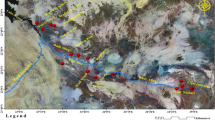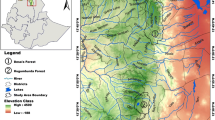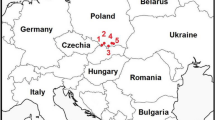Abstract
The accuracy of direct (based on increment cores) and indirect (based on age-size relationships) methods of tree age estimation in Fagus sylvatica and Quercus robur was tested. This was done through increment cores and stem discs taken in an old-growth forest of Northern Spain. It was found that cross-dating was more precise than ring counting by up to 7 years per tree. Furthermore, cross-dating permitted the estimation of the age of trees with floating ring-width series, which were 7% of cored F. sylvatica and 40% of Q. robur ones. In partial cores with the arcs of the inner rings, the length of the missing radius was estimated with both a geometric method, based on the curvature of the arcs, and a new graphical method, based on the convergence of xylem rays at the pith. The graphical method was more accurate when the radial growth was eccentric, as happens in Q. robur, while both methods showed a similar accuracy for F. sylvatica, whose growth is relatively concentric. Empirical models of initial radial growth (IRG), built to estimate the number of missing rings, reduced the errors associated with other methods that assume constant growth rates. Age estimates obtained from the graphical method combined with the IRG models were within 4% of the actual age. This combination ensured age estimates with a mean accuracy of 8 years for 98% of the F. sylvatica trees, and 4 years for 89% of the Q. robur. In partial cores without the arcs of the inner rings, the length of the missing radius was estimated as the distance to the geometric centre of the tree. In that case, age estimates obtained by extrapolating the mean growth rate of the 20 innermost rings in the cores were from 10 to 20% of actual age, which coincided with results obtained in other tree species with this method. Finally, the age-diameter equations of the different cohorts produced better age estimates (from 8 to 14% of actual age) than equations of the population as a whole (from 20 to 40% of actual age). These results proved that the errors derived from doubtful assumptions, such as concentric radial growth, constant growth and recruitment rates, or the absence of anomalous rings, could be reduced by applying more realistic methods of tree age estimation.
Similar content being viewed by others
References
Ågren J. and Zackrisson O. 1990. Age and size structure of Pinus sylvestris populations on mires in central and northern Sweden. Journal of Ecology 78: 1049–1062.
AIWA 1989. IAWA list of microscopic features for hardwood identification. IAWA Bulletin 10: 219–332.
Baker W.L. 1992. Structure, disturbance, and change in the bristlecone pine forests of Colorado, USA. Arctic and Alpine Research 24: 17–26.
Brodie C., Houle G. and Fortin M.-J. 1995. Development of a Populus balsamifera clone in subarctic Québec reconstructed from spatial analyses. Journal of Ecology 83: 309–320.
Dietz H. and Ullmann I. 1997. Age determination of dicotyledonous perennials by means of annual rings: exception or rule? Annals of Botany 80: 377–379.
Donnegan J.A. and Rebertus A.J. 1999. Rates and mechanisms of subalpine forest succession along an environmental gradient. Ecology 80: 1370–1384.
Duncan R. 1989. An evaluation of errors in tree age estimates based on increment cores in kahikatea (Dacrycarpus dacrydioides). New Zealand Natural Sciences 16: 31–37.
Duncan R.P. 1993. Flood disturbance and the coexistence of species in a lowland podocarp forest, south Westland, New Zealand. Journal of Ecology 81: 403–416.
Fernández-Palacios J.M. and Arévalo J.R. 1998. Regeneration strategies of tree species in the laurel forest of Tenerife (The Canary Islands). Plant Ecology 137: 21–29.
Frelich L.E. and Graumlich L.J. 1994. Age-class distribution and spatial patterns in an old-growth hemlock-hardwood forest. Canadian Journal of Forest Research 24: 1939–1947.
Fritts H.C. 1976. Tree Rings and Climate. Academic Press, London.
Harper J.L. 1977. Population Biology of Plants. Academic Press, London.
Henry J.D. and Swan J.M.A. 1974. Reconstructing forest history from live and dead plant material–An approach to the study of forest succession in southwest New Hampshire. Ecology 55: 772–783.
Holmes R.L. 1983. Computer-assisted quality control in tree-ring dating and measurement. Tree-Ring Bulletin 43: 69–78.
Johnson E.A. and Fryer G.I. 1989. Population dynamics in lodgepole pine-Engelmann spruce forests. Ecology 70: 1335–1345.
Kaennel M. and Schweingruber F.H. 1995. Multilingual Glossary of Dendrochronology. Terms and Definitions in English, German, French, Spanish, Italian, Portuguese, and Russian. Swiss Federal Institute for Forest, Snow and Landscape Research, Haupt, Stuttgart.
Kelly P.E. and Larson D.W. 1997. Dendroecological analysis of the population dynamics of an old-growth forest on cliff-faces of the Niagara Escarpment, Canada. Journal of Ecology 85: 467–478.
Koop H. 1987. Vegetative reproduction of trees in some European natural forests. Vegetatio 72: 103–110.
Lorimer C.G. 1980. Age structure and disturbance history of a southern Appalachian virgin forest. Ecology 61: 1169–1184.
Lusk C. and Ogden J. 1992. Age structure and dynamics of a podocarp-broadleaf forest in Tongariro National Park, New Zealand. Journal of Ecology 80: 379–393.
Lusk C.H. and Smith B. 1998. Life history differences and tree species coexistence in an old-growth New Zealand rain forest. Ecology 79: 795–806.
Mikan C.J., Orwig D.A. and Abrams M.D. 1994. Age structure and successional dynamics of a presettlement-origin chestnut oak forest in the Pennsylvania Piedmont. Bulletin of the Torrey Botanical Club 121: 13–23.
Nakashizuka T. and Numata M. 1982. Regeneration process of climax beech forests I. Structure of a beech forest with the undergrowth of Sasa. Japanese Journal of Ecology 32: 57–67.
Norton D.A. and Ogden J. 1990. Problems with the use of tree rings in the study of forest population dynamics. In: Cook E.R. and Kairiukstis L.A. (eds), Methods of Dendrochronology: Applications in the Environmental Science. Kluwer Academic Publishers, Dordrecht, pp. 284–288.
Norton D.A., Palmer J.G. and Ogden J. 1987. Dendroecological studies in New Zealand 1. An evaluation of tree age estimates based on increment cores. New Zealand Journal of Botany 25: 373–383.
Ogden J. 1985. Past, present and future: Studies on the population dynamics of some long-lived trees. In: White J. (ed.), Studies on Plant Demography: A Festschrift for John L. Harper. Academic Press, London, pp. 3–16.
Ohkubo T. 1992. Structure and dynamics of Japanese beech (Fagus japonica Maxim.) stools and sprouts in the regeneration of the natural forests. Vegetatio 101: 65–80.
Rozas V. 2001. Detecting the impact of climate and disturbances on tree-rings of Fagus sylvatica L. and Quercus robur L. in a lowland forest in Cantabria, Northern Spain. Annals of Forest Science 58: 237–251.
Schweingruber F.H. 1990. Anatomy of European Woods. Swiss Federal Institute for Forest, Snow and Landscape Research, Haupt, Stuttgart.
Stephenson P.L. and Demetry A. 1995. Estimating ages of giant sequoias. Canadian Journal of Forest Research 25: 223–233.
Stewart G.H. 1986. Population dynamics of a montane conifer forest, western Cascade Range, Oregon, USA. Ecology 67: 543–544.
Stewart G.H. and Rose A.B. 1990. The significance of life history strategies in the developmental history of mixed beech (Nothofagus) forests, New Zealand. Vegetatio 87: 101–114.
Stokes M.A. and Smiley T.L. 1968. An Introduction to Tree-Ring Dating. University of Chicago Press, Chicago.
Szeicz J.M. and MacDonald G.M. 1995. Recent white spruce dynamics at the subarctic alpine treeline of north-western Canada. Journal of Ecology 83: 873–885.
Tardif J. and Bergeron Y. 1999. Population dynamics of Fraxinus nigra in response to flood-level variations, in northwestern Quebec. Ecological Monographs 69: 107–125.
Taylor A.H., Qin Zisheng and Liu Jie 1996. Structure and dynamics of subalpine forests in the Wang Lang Natural Reserve, Sichuan, China. Vegetatio 124: 25–38.
Telewski F.W. 1993. Determining the germination date of woody plants: A proposed method for locating the root/shoot interface. Tree-Ring Bulletin 53: 13–16.
Tutin T.G., Heywood V.H., Burges N.A., Moore D.M., Valentine D.H., Walters S.M. et al. (eds) 1964-68. Flora Europaea. I–II. Cambridge University Press, London.
Veblen T.T. 1989. Nothofagus regeneration in treefall gaps in northern Patagonia. Canadian Journal of Forest Research 19: 365–371.
Veblen T.T. 1992. Regeneration dynamics. In: Glenn-Lewin D.C., Peet R.K. and Veblen T.T. (eds), Plant Succession: Theory and Prediction. Chapman & Hall, London, pp. 152–187.
Villalba R. and Veblen T.T. 1997. Improving estimates of total tree ages based on increment core samples. Ecoscience 4: 534–542.
Wong C.M. and Lertzman K.P. 2001. Errors in estimating tree age: implications for studies of stand dynamics. Canadian Journal of Forest Research 31: 1262–1271.
Worbes M. 1999. Annual growth rings, rainfall-dependent growth and long-term growth patterns of tropical trees from the Caparo Forest Reserve in Venezuela. Journal of Ecology 87: 391–403.
Author information
Authors and Affiliations
Rights and permissions
About this article
Cite this article
Rozas, V. Tree age estimates in Fagus sylvatica and Quercus robur: testing previous and improved methods. Plant Ecology 167, 193–212 (2003). https://doi.org/10.1023/A:1023969822044
Issue Date:
DOI: https://doi.org/10.1023/A:1023969822044




